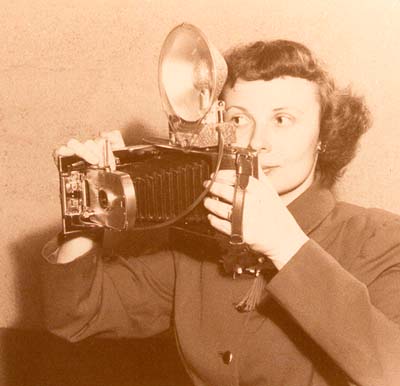J. Crew keeps actual Moroccans mostly out of the picture in their newest "Morocco" catalog, like the blurred sheepherder in this shot (click on the images for larger versions):
 The one time they do incorporate native Moroccans, we get an unintentionally hilarious shot--notice where the "local guerrab (water man)" is looking!
The one time they do incorporate native Moroccans, we get an unintentionally hilarious shot--notice where the "local guerrab (water man)" is looking!
You would think Vogue would stay away from controversial images involving race considering the criticism they recently endured for their LeBron James and Jennifer Hudson covers. This may be why they cast black Ethiopian model Liya Kebede in their photo shoot in Mali (an unfortunate reason to cast a black model). But does it erase the elitist overtones when you use a model of color?
The piece is breathlessly narrated by Sally Singer, who writes of Djenne that "everyone in this bustling market town looks as if they've stepped off the Dries Van Noten catwalk." Riiight. The contrast in expressions and attitudes between the women in the marketplace and the model, despite the similar prints on their clothes, is what fascinates about this photo:

There is another strange photo whose caption reads "Malian children mix traditional textiles with items recycled from the West--'a testament to a visual culture that's profound and inclusive.'" It seems doubtful that the boy in this photo ordered his stained Beaver Creek Colorado sweatshirt from Net-a-Porter trying to mix and match. Aren't these Western clothes castaways donated by American charities?

It's hard not to see the colonialist overtones in this next photo: the traditional outfit, the sherpa walking several paces behind the model, carrying a tiny leather handbag. Notice how many cars are waiting in this ferry line to Timbuktu. The narrator has just informed us that while native Malians wait for hours and hours to be ferried across, the photo shoot crowd simply left their cars with drivers and "hired a boatman to row us across in a long canoe."

Given the number of global, particularly African, influences in fashion this season, it's not surprising that fashion editors would choose to set photo shoots in Africa. But the resulting photographs raise issues that were easily forgotten in the sanitized, rock-music-fueled environs of an Oscar de la Renta show. Where are these prints from, how did Western designers end up appropriating them, and what does it all mean? Are Americans any better than the Europeans who became infatuated with Orientalism at the turn of the last century, or have we merely adapted the same attitudes to a different continent, 100 years later?








